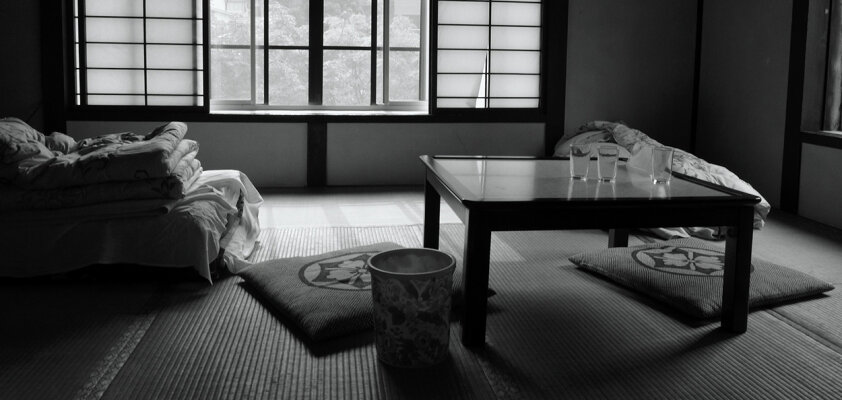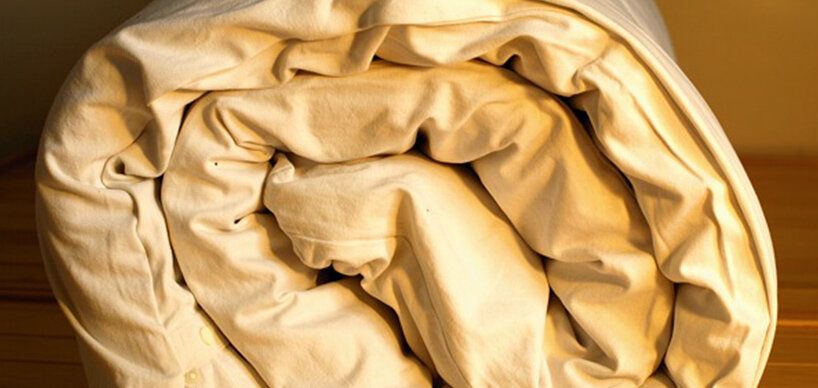How the Futon Conquered the Bedroom

Sleeping like in Japan: This is only truly authentic on a Futon. Get comfortable and be surprised by what the Japanese mattress can do and why it is so popular even outside Japan.
What is futon and what is not?
Just a mattress? A Futon (布団) is more than that. First of all, the term "Futon" can refer to the mattress itself or the entire package. However, for many Japanese, any type of bed is called a "Futon" at least in language usage. A complete, traditional Japanese bed consists of at least two parts: The Shikibuton (literally "spread out Futon," 敷き布団) which is the mattress itself, including a mattress topper, and the Kakebuton (literally "covering Futon," 掛け布団), which is the (quilted) comforter.
In addition, there is the Makura (枕), the pillow. Instead of animal fibers or fabric, it is filled with buckwheat or beans. It may sound uncomfortable at first, but it works wonders for the neck and shoulders: The pillow perfectly adapts to the head and sleeping position and has a natural insulating function that depends on the temperature. Thus, it provides warmth in cold weather, similar to a grain-filled pillow, and cools pleasantly when it gets too warm. Makura pillows, with their supporting and massaging effect, can even alleviate and counteract pain and misalignments. Another factor contributing to this is the smaller length of up to 30 cm, and Makura pillows come in many different shapes depending on personal preference.
But the Kakebuton is also special. This quilt is traditionally made of 100% pure cotton, just like the Futon. Many things of good quality and authenticity in Japan are carefully handmade, and this quality comes at a price. However, this quilt brings many benefits: Firstly, the Kakebuton is made of natural material that eliminates mold and mites. Additionally, the quilt is pleasantly warm and breathable, making it a delight in summer nights. Adorned with typical Japanese patterns, the Kakebuton can quickly become an eye-catching piece.
Sleep better since ...
The Futon evolved and revolutionized the sleeping culture in Japan over the ages. Until around the 12th century, sleeping mats were woven from rush and rice straw and placed on wood. However, they were too thin to provide adequate comfort and had to be layered. This led to the creation of the Tatami mat: initially used as seating for nobles and bedding for samurai, it covered entire rooms by the 16th century at the latest. As the cultivation of rice and other plants became more efficient, there was more than enough straw for the bedroom.
Moreover, in Japan, affluent individuals had a pillow in addition to their straw mat, or even a kind of silk canopy bed that enjoyed great popularity among the nobility around the 8th century. Apart from the aesthetic aspect, it also had a practical purpose: it provided protection against annoying insects in the summer and biting cold in the winter.
When Tatami mats found their way into Japanese homes, cotton-filled quilts were also used: the Kakebuton was born. Interestingly, the first Kakebuton had sleeves, but they were not used for the arms. Instead, they were laid out on the sides of the Futon for warmth and to stabilize the quilt. However, it would take some time before the first comfortable and warm cotton Futon beds appeared. Only during the Edo period (1603 to 1868), did cotton production boom, making it affordable for everyone to sleep on.
The fact that Tatami mats were once used for sleeping is reflected in the slightly elevated Tokonoma in Japanese homes: a small alcove where paintings, Ikebana, or other art objects are placed. The bedroom was once a place that was often decorated, evolving into the center of the house where guests were received.
A bed with many talents
From Japan, the Futon arrived in Europe around the 1980s. With its naturalness, minimalist elegance, practical nature, and the many health benefits, it quickly became successful. But what sets Futons apart from mattresses, such as latex mattresses, as we know them? Usually, a Futon is made of pure cotton, quilted with felt buttons, and quite thin: About 5 to 10 cm thick, equivalent to six layers of cotton, Futons are manufactured. Their length and width are traditionally smaller than what we are used to, with dimensions of 180 by 90 cm, tailored to Japanese needs: The measurements correspond to a Tatami mat on which a Futon is unrolled in Japan. However, a freshly purchased Futon may expand after some time, making it initially appear small. Of course, there are now variations in all conceivable sizes for those who want more sleeping space. Additionally, Futon beds are more robust and do not sag as quickly as Western mattresses. This makes them very durable, saving you a lot of money and space with such an affordable bed.

Picture Credits: Author: Toby Oxborrow | Flickr | License
A Futon mattress is simultaneously environmentally friendly, free from pollutants, and comfortable, not to mention that it does not build up static charge. Aside from the practical aspect that the Futon is compact and rollable, its firm character is beneficial for the back – especially for side sleepers. According to ancient Japanese wisdom, a hard surface makes the body tougher and resistant to diseases and pains. Modern studies also confirm long ago that mattresses that are too soft can cause back problems.
For those who find an authentic Japanese Futon too hard, there is a wide selection of modern variations of Futon mattresses that come with various materials. You can easily find them online and in specialty stores. These materials offer different capabilities:
- Foam makes the Futon softer and optimally distributes body weight
- Latex or rubber provides elasticity and does not dust, pleasing allergy sufferers
- Sheep's wool provides excellent warmth, is self-cleaning, and absorbs moisture and odor without leaving a trace
- Horsehair keeps the Futon mattress dry and robust
- Plant-based ingredients like hemp or coconut ensure optimal ventilation and insulation of the Futon
Relax like in Japan
Even today, Japanese people like to take their nap on Tatami mats. However, since this is common almost anywhere, whether on a train or in the office, it is questionable whether the straw covering would be comfortable for us. On the other hand, a Futon bed offers comfort for a good and sound sleep.
In the simple, traditional Japanese version, the Futon is still unrolled on the Tatami mat. In a slightly more luxurious version adapted to the western lifestyle, the Japanese bed is made of wood or metal. It is still lower than the European one and essentially consists of boards. This makes such a Futon bed flat and space-saving. From simple designs that match Japanese aesthetics to extravagant, rounded, and decorated variants, everything is possible. Storage drawers can also be built in.
It is also possible to place a Futon on a classic bed with a slatted frame, on a frame, or to reinterpret it as a sofa bed – the imagination knows no bounds. However, since the classic, thin Futon is optimized for Tatami and the floor, in such cases, it is better to opt for a mixed model rather than pure cotton. These types mentioned above are suitable for the western bed or sofa bed and can be placed on slatted frames like conventional mattresses, as they are slightly thicker and adapted to European conditions. This way, Futon beds are softer and provide optimal sleeping comfort when you want to sleep at a higher level.
For small apartments, a built-in bed frame in the wall that can disappear into the wall along with the Futon is suitable. But even on its own, the thin and flexible Futon can be easily rolled up and stowed away, allowing the space of the bed to be used for other purposes during the day. In small Japanese apartments, there is often no separate bedroom, and every bit of gained space is valuable. Such flexibility is also advantageous for moving. Specifically for this, traditional Japanese houses have built-in closets (Oshiire).
Model for massaging or meditating
However, a Futon is not just for sleeping. Such a versatile mat is suitable for various activities, and the different variants of the Japanese mattress make this clear.
For a relaxing massage, the Shiatsu Futon is excellent. Shiatsu is a relaxing Japanese finger pressure massage that focuses on the harmony and balance between body and mind. A Shiatsu Futon usually consists of four layers of cotton, making it slightly thinner and firmer than the sleeping Futon. However, it provides a firm, secure, and insulating surface for effective and soothing Shiatsu massages. There are also special sheets and pillows that can withstand massage oil. Some people also use such a mat for yoga, and when guests are announced, it can be very useful as a guest mattress.
From the Edo period comes another member of the Futon "family": The Zabuton (literally "sitting Futon", 座布団), which serves as a seat cushion for meditation. Or as a base because a round, soft Zafu is often placed on the Zabuton. This construction traditionally provides a comfortable seat and a suitable posture for Zazen meditation, both in the temple and at home: straight and slightly bent forward. In addition, a good base protects against cold surfaces.
Proper care of futon mattresses
To ensure that a robust Futon serves you well for a long time, it only needs some care. For this, you should regularly air and dry it, preferably outdoors in the sun. For those without a balcony or terrace to hang it out, there are even special drying devices that blow warm air through the Futon mattress and the Kakebuton, similar to a hairdryer.

Picture Credits: Author: Chris RubberDragon | Flickr | License
Rolling it up daily is also important to prevent absorbed moisture from staying in the cotton: when the Futon is rolled up, the absorbent fibers unfold again. Additionally, rolling prevents the Futon from becoming too firm, as upright cotton fibers provide a softer and cozier surface.
The cotton cover that protects the Futon bed cannot be removed, but it doesn't need washing. Of course, you can additionally cover it yourself, but make sure there is sufficient ventilation. A "modern" Futon with a mix of materials is somewhat easier to care for, but it usually cannot be rolled up as well. Regularly turning and airing the Futon can help in this case.
A Futon is for everyone: whether you want to live more minimally and naturally, improve your sleep, or simply try something new. The best composition and style for you personally can only be found through trial and error. So, onto the Futon and relax!











-from-the-yakiyaki-grill-pan.jpg)




